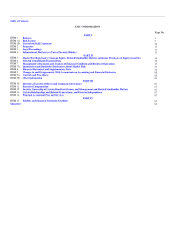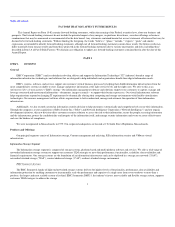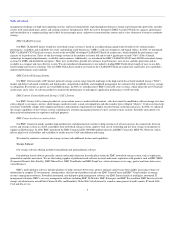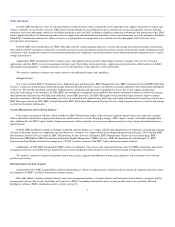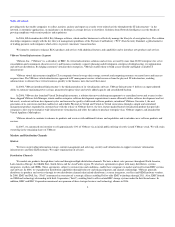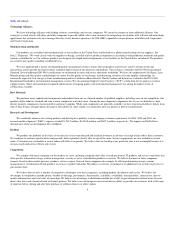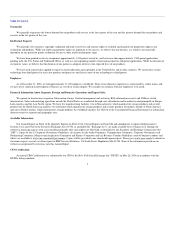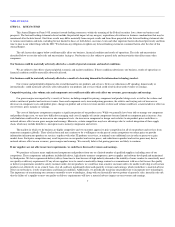EMC 2006 Annual Report Download - page 13
Download and view the complete annual report
Please find page 13 of the 2006 EMC annual report below. You can navigate through the pages in the report by either clicking on the pages listed below, or by using the keyword search tool below to find specific information within the annual report.
Table of Contents
The markets we serve are highly competitive and we may be unable to compete effectively.
We compete with many companies in the markets we serve, certain of which offer a broad spectrum of IT products and services and others which offer
specific information storage, management or virtualization products or services. Some of these companies (whether independently or by establishing
alliances) may have substantially greater financial, marketing and technological resources, larger distribution capabilities, earlier access to customers and
greater opportunity to address customers' various IT requirements than us. In addition, as the IT industry consolidates, companies may improve their
competitive position and ability to compete against us. We compete on the basis of our products' features, performance and price as well as our services. Our
failure to compete on any of these bases could affect demand for our products or services, which could have a material adverse effect on our business, results
of operations or financial condition.
Companies may develop new technologies or products in advance of us or establish business models or technologies disruptive to us. Our business may
be materially adversely affected by the announcement or introduction of new products, including hardware and software products and services by our
competitors, and the implementation of effective marketing or sales strategies by our competitors. The material adverse effect to our business could include a
decrease in demand for our products and services and an increase in the length of our sales cycle due to customers taking longer to compare products and
services and to complete their purchases.
We may have difficulty managing operations.
Our future operating results will depend on our overall ability to manage operations, which includes, among other things:
• retaining and hiring, as required, the appropriate number of qualified employees
• managing, protecting and enhancing, as appropriate, our infrastructure, including but not limited to, our information systems and internal controls
• accurately forecasting revenues
• training our sales force to sell more software and services
• successfully integrating new acquisitions
• managing inventory levels, including minimizing excess and obsolete inventory, while maintaining sufficient inventory to meet customer demands
• controlling expenses
• managing our manufacturing capacity, real estate facilities and other assets
• executing on our plans
An unexpected decline in revenues without a corresponding and timely reduction in expenses or a failure to manage other aspects of our operations
could have a material adverse effect on our business, results of operations or financial condition.
Our business could be materially adversely affected as a result of war or acts of terrorism.
Terrorist acts or acts of war may cause damage or disruption to our employees, facilities, customers, partners, suppliers, distributors and resellers, which
could have a material adverse effect on our business, results of operations or financial condition. Such conflicts may also cause damage or disruption to
transportation and communication systems and to our ability to manage logistics in such an environment, including receipt of components and distribution of
products.
Our business may suffer if we are unable to retain or attract key personnel.
Our business depends to a significant extent on the continued service of senior management and other key employees, the development of additional
management personnel and the hiring of new qualified employees. There can be no assurance that we will be successful in retaining existing personnel or
recruiting new personnel. The loss of one or more key or other employees, our inability to attract additional qualified employees or the delay in hiring key
personnel could have a material adverse effect on our business, results of operations or financial condition.
In addition, we have historically used stock options and other equity awards as key elements of our compensation packages for many of our employees.
Under recent accounting rules, we are required to treat stock-based compensation as an expense. In addition, changes to regulatory or stock exchange rules
and regulations and in institutional shareholder voting guidelines on equity plans may result in additional requirements or limitations on our equity plans. As a
result, we may change our compensation practices with respect to the number of shares and type of equity awards used. The value of our equity awards may
also be adversely affected by the volatility of our stock price. These factors may impair our ability to attract, retain and motivate employees.
9



